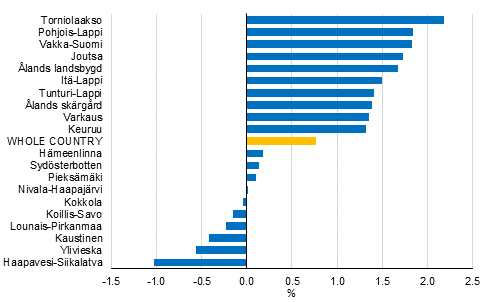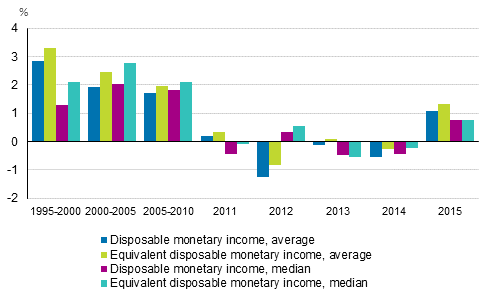This set of statistics has been discontinued.
Statistical data on this topic are published in connection with another set of statistics.
Data published after 5 April 2022 can be found on the renewed website.
Published: 20 December 2016
Real income of household-dwelling units has made an upturn
In 2015, household-dwelling units' median income was in real terms 0.8 per cent higher than one year before. Income grew most in the sub-regional unit of Torniolaakso, by 2.2 per cent. Income grew by 1.8 per cent in the sub-regional units of Pohjois-Lappi and Vakka-Suomi. Income development was weakest in the sub-regional unit of Haapavesi-Siikalatva, where income went down by one per cent. Statistics Finland's Total statistics on income distribution show that real income also decreased in the sub-regional units of Ylivieska and Kaustinen located in the same area.
Annual change in household-dwelling units’ median income in 2015, %. Ten sub-regional units with the largest and smallest change

Income concept equivalent disposable monetary income of the household-dwelling unit, median. Equivalent disposable monetary income = disposable monetary income of the household-dwelling unit divided by the household-dwelling unit’s consumption unit figure.
In the whole country, the equivalent median income of household-dwelling units was EUR 22,750 last year. In the sub-regional unit of Helsinki, which is the biggest by population, the corresponding income was EUR 25,680, growing by 0.8 per cent from the year before. The sub-regional unit of Helsinki has good 700,000 household-dwelling units.
In the sub-regional unit of Tampere, the equivalent median income of good 190,000 household-dwelling units was EUR 22,400, which was 0.9 per cent more than one year before. A similar income growth was also reached by the 160,000 household-dwelling units in the sub-regional unit of Turku. The median income of household-dwelling units was EUR 22,370 in the sub-regional unit of Turku. In the sub-regional unit of Oulu, the equivalent median income of 110,000 household-dwelling units was EUR 22,200, which was in real terms 0.8 per cent more than in 2014.
The sub-regional units where income increased most included both sub-regional units with low and high income. Sub-regional units with the highest income included Åland's sub-regional units of Ålands landsbygd and Ålands skärgård, where household-dwelling units' equivalent disposable income was in 2015 highest of all sub-regional units: in the former EUR 27,600 and in the latter EUR 25,690. The household-dwelling units of Joutsa had clearly the lowest income in this group, as there the equivalent median income was EUR 19,800.
The income levels of household-dwelling units in sub-regional units with the least income growth were low all through. Households in the sub-regional unit of Hämeenlinna had the highest income (EUR 23,000) and household-dwelling units in Koillis-Savo the lowest (EUR 19,280).
Light can be seen in the income development of Finnish households
The income development of Finnish households has been weak in recent years. The real annual change in household-dwelling units' disposable monetary income has been negative in many years in a row in the 2010s, but the year 2015 appears better for a long time: according to both average and median, household-dwelling units' income grew clearly compared with a few previous years. Measured by average, growth in real income exceeded the threshold of one per cent last year, measured by median income, income growth was 0.8 per cent.
Real annual changes in household-dwelling units’ income in 1995 to 2015

Income changes in 1995 to 2000, 2000 to 2005 and 2005 to 2010 are average annual changes in those periods.
Source: Total statistics on income distribution, Statistics Finland
Inquiries: Pekka Ruotsalainen 029 551 2610
Director in charge: Jari Tarkoma
- Tables
-
Tables in databases
Pick the data you need into tables, view the data as graphs, or download the data for your use.
Updated 20.12.2016
Official Statistics of Finland (OSF):
Total statistics on income distribution [e-publication].
Income development by area 2015. Helsinki: Statistics Finland [referred: 16.12.2025].
Access method: http://stat.fi/til/tjkt/2015/01/tjkt_2015_01_2016-12-20_tie_001_en.html

